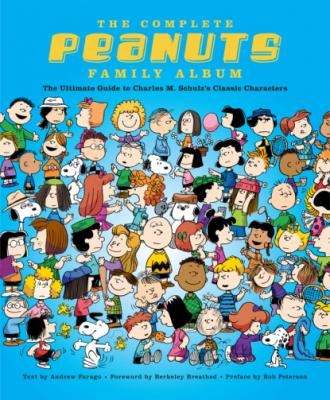The Complete Peanuts Family Album. Andrew Farago
Читать онлайн.| Название | The Complete Peanuts Family Album |
|---|---|
| Автор произведения | Andrew Farago |
| Жанр | Юмористические стихи |
| Серия | |
| Издательство | Юмористические стихи |
| Год выпуска | 0 |
| isbn | 9781681887531 |
evening. Mike fell into the role of the quick-tempered
smart aleck; Sulley was more clear-headed and controlled.
Each of the Peanuts characters had this—a clear personality
type. But it is when Schulz puts them in contrast with other
“side” characters that we get to see their depth. Linus’s
religious zealotry is put to the test in the Great Pumpkin
patch by Sally. The little red-haired girl, whom we never
see (a little red herring), brings out the romantic side in
Charlie Brown. Without her, we only see the insecure
Charlie. And on and on . . . Schulz created a world of
characters in which contrast of the side characters clarified
the main characters.
I am thankful every day that Schulz created this world
and left a legacy of lessons for storytellers, and now I’m
pondering next year’s costume.
Most of us familiar with Charles M. Schulz’s artwork recog-
nize it from the 17,897 Peanuts comic strips he wrote and
drew over his fifty-year career. And much of that artwork has
been used and modified in a variety of media for almost as
long, filtered through animation, commercial design, print,
and character licensing across the world. The artwork pre-
sented in The Complete Peanuts Family Album comes from
an array of sources and a diverse group of artists, including
designers from Peanuts Worldwide (PW) and Charles M.
Schulz Creative Associates (CSCA); some items come from
the archives of the Charles M. Schulz Museum (CMSM)
and some pieces have been specifically created for this book.
Regardless of the source, all of the artwork presented here is
lovingly inspired by Charles M. Schulz’s original work.
PREFACE
BY BOB PETERSON
opposite: Style Guide art – CSCA
11PREFACE
13INTRODUCTION
opposite: TIME® magazine cover, April 9, 1965 – CMSM
W
ho’s your favorite Peanuts character?
Or, to put it another way, what’s wrong with you?
Maybe you have autophobia, the fear of loneliness. In
that case, you probably relate to Charlie Brown and his
endless list of anxieties, his wishy-washy nature, and his
complete inability to fly a kite. (Science has not yet named
the fear of Kite-Eating Trees, sadly.)
Do you have sedatephobia, the fear of silence? You’d
probably get along well with Lucy, Miss Fussbudget of
the Year since 1952, who has literally cursed the darkness
rather than light a single candle.
It’s possible you’ve got ailurophasia, the fear of cats,
in which case you’d get along just fine with Snoopy and
Woodstock—just don’t tell Frieda.
And if you suffer from arithmophobia, the fear of
numbers, you’d best avoid 555 95472 and his sisters, 3 and
4, altogether.
Whatever your affliction, rest assured that there’s at least
one Peanuts character who can sympathize with you over
jelly-bread sandwiches and a frosty mug of root beer.
But what about problems more complex than the fear
of cats, numbers, or numbers of cats? If that’s the case,
you may identify with some of these Peanuts characters
that have never actually appeared in the strip (although
none of them seem to actually have scopophobia, the fear
of being seen).
Do you have a fear of sports? Perhaps you and Charlie
Brown’s unfortunate baseball idol Joe Shlabotnik suffer
from athlimataphobia.
What about the fear of eggs? We’ll never know why
Linus was supposed to bring discarded eggshells to Miss
Othmar’s classroom, but that sounds like a classic case of
ovaphobia, doesn’t it?
And what if the Little Red-Haired Girl wasn’t
avoiding Charlie Brown at all, but was simply frozen by
chorophobia, the fear of dancing? Or even more tragic,
philophobia, the fear of love itself? A single therapy session
at Lucy’s psychiatric booth could have completely changed
her perspective on life.
There are a number of memorable unseen locales in
Peanuts, too, including the interior of Snoopy’s doghouse.
A combination of the fear of houses, domatophobia, and
the fear of dogs, cynophobia, may keep you from learning
just how Snoopy has managed to fit a recreation room, a
den, a cedar closet, a guest room, a whirlpool bath, and an
Andrew Wyeth painting inside a standard-issue doghouse.
When Peanuts debuted in seven newspapers on
October 2, 1950, its world was a little simpler. Charles
Schulz’s initial cast of characters consisted of Charlie
Brown, his dog, Snoopy, and his friends Patty and Shermy.
Their personalities weren’t clearly defined in the strip’s
early days, but as new characters like Violet, Schroeder,
Lucy, Linus, Pig-Pen, and Sally were introduced, everyone’s
role came into focus. By the end of the strip’s first decade,
Peanuts truly came into its own as the home of some of
the most beloved characters in comic strip history.
The additions of Peppermint Patty, Marcie, and
Franklin in the second half of the 1960s expanded the
Peanuts universe across town to the neighboring school
district. The extended cast provided Charles Schulz
with even greater storytelling possibilities, and more
opportunities for self-expression, as he noted in a 1984
interview. “I think anybody who is writing finds he puts
a little bit of
